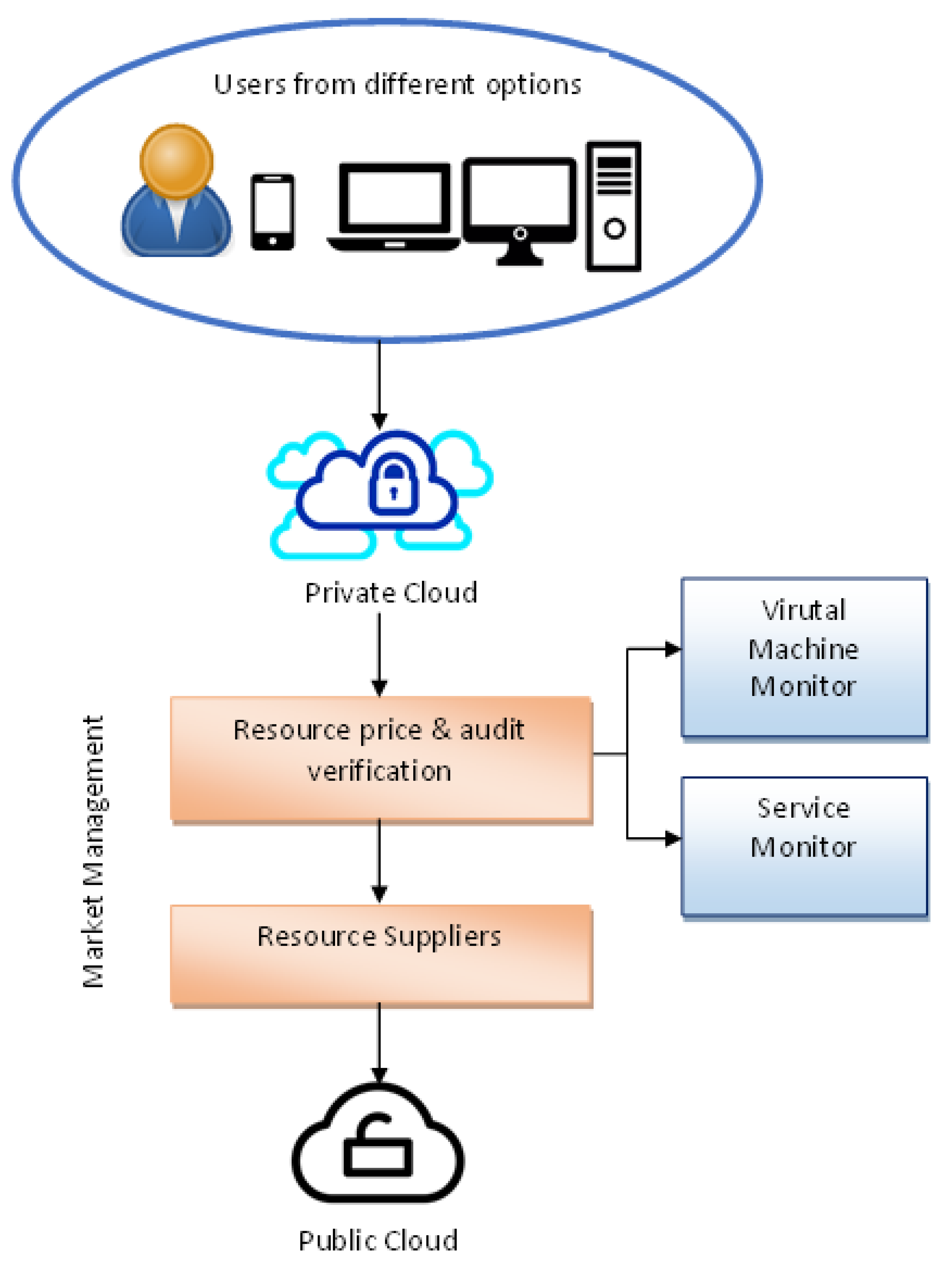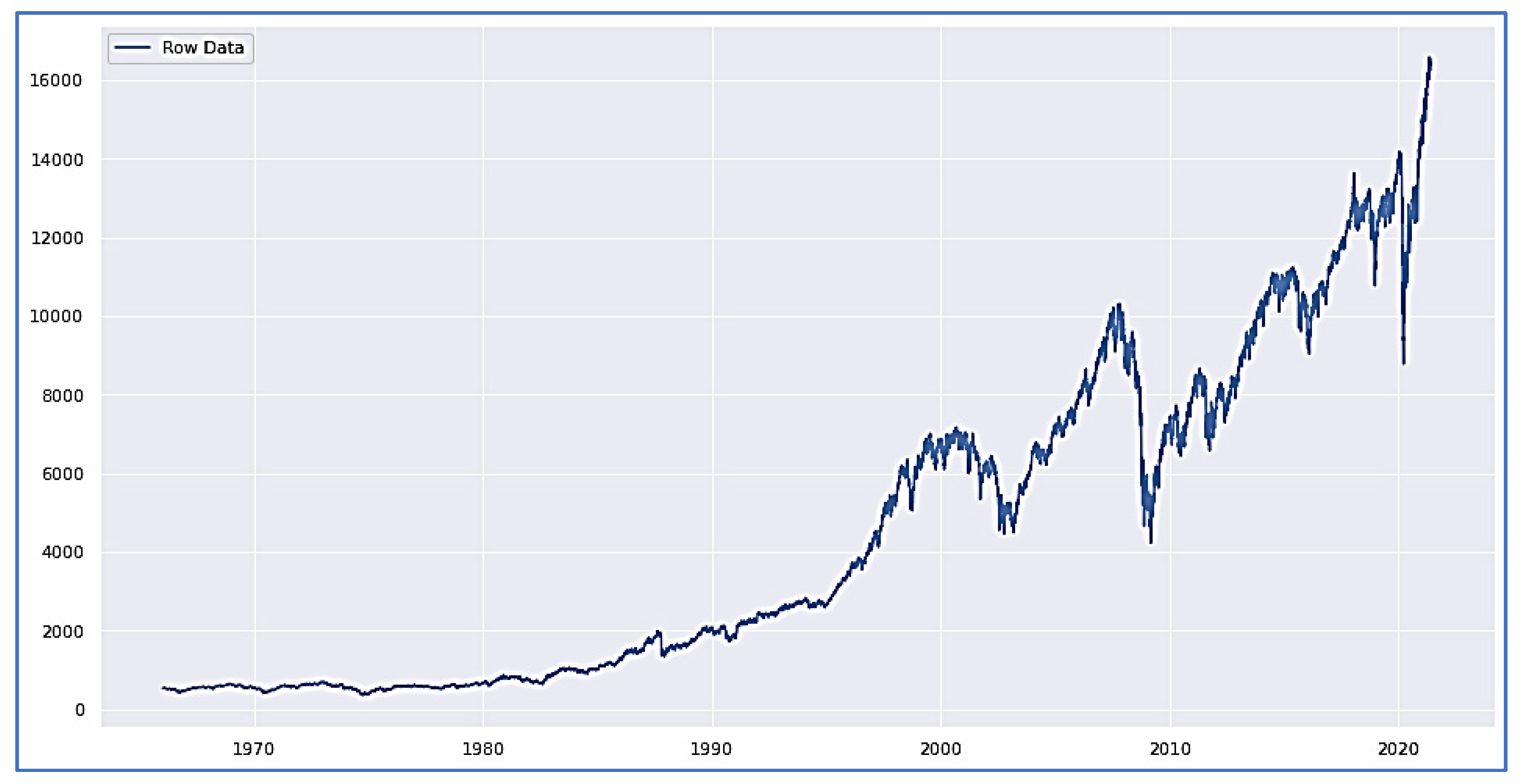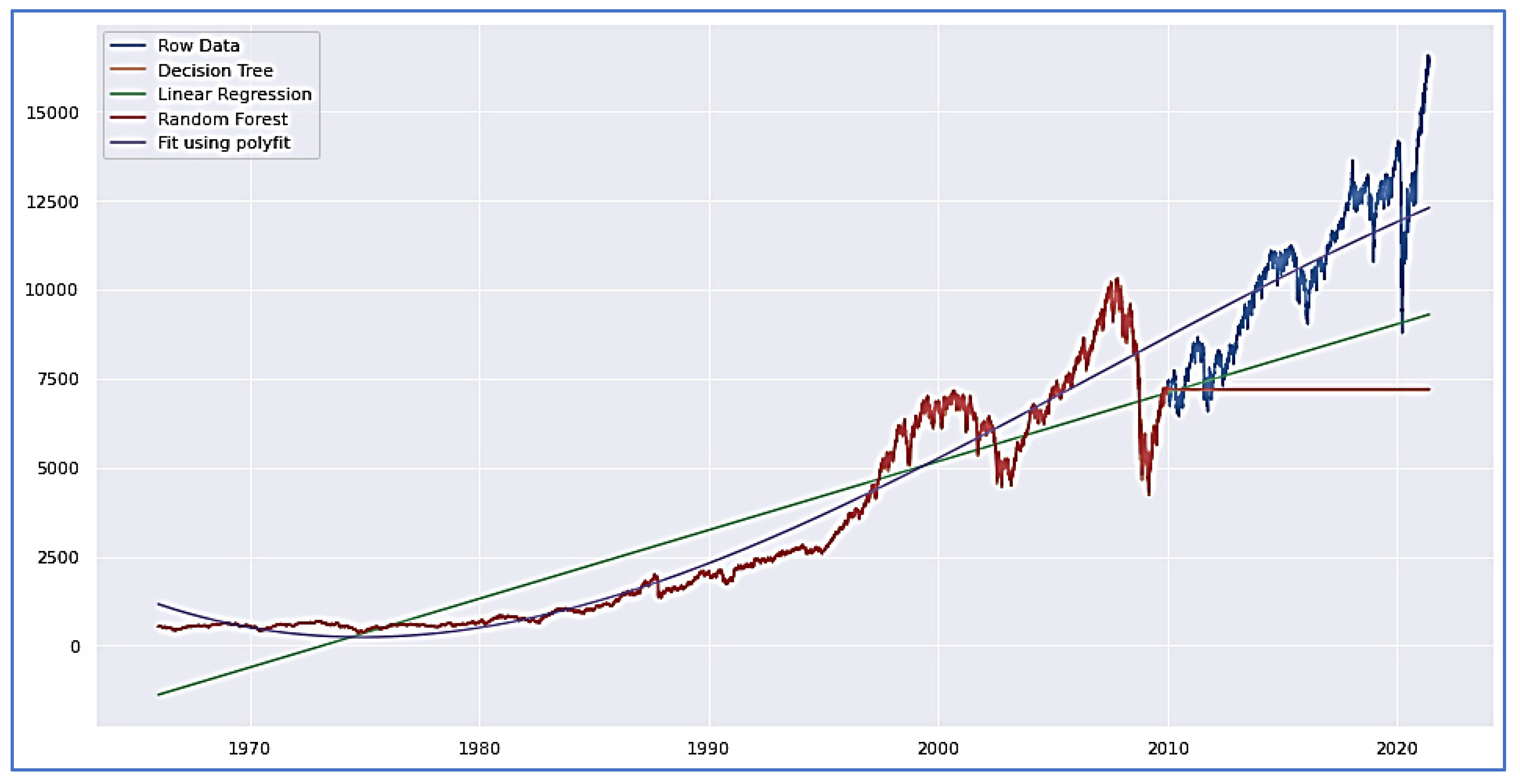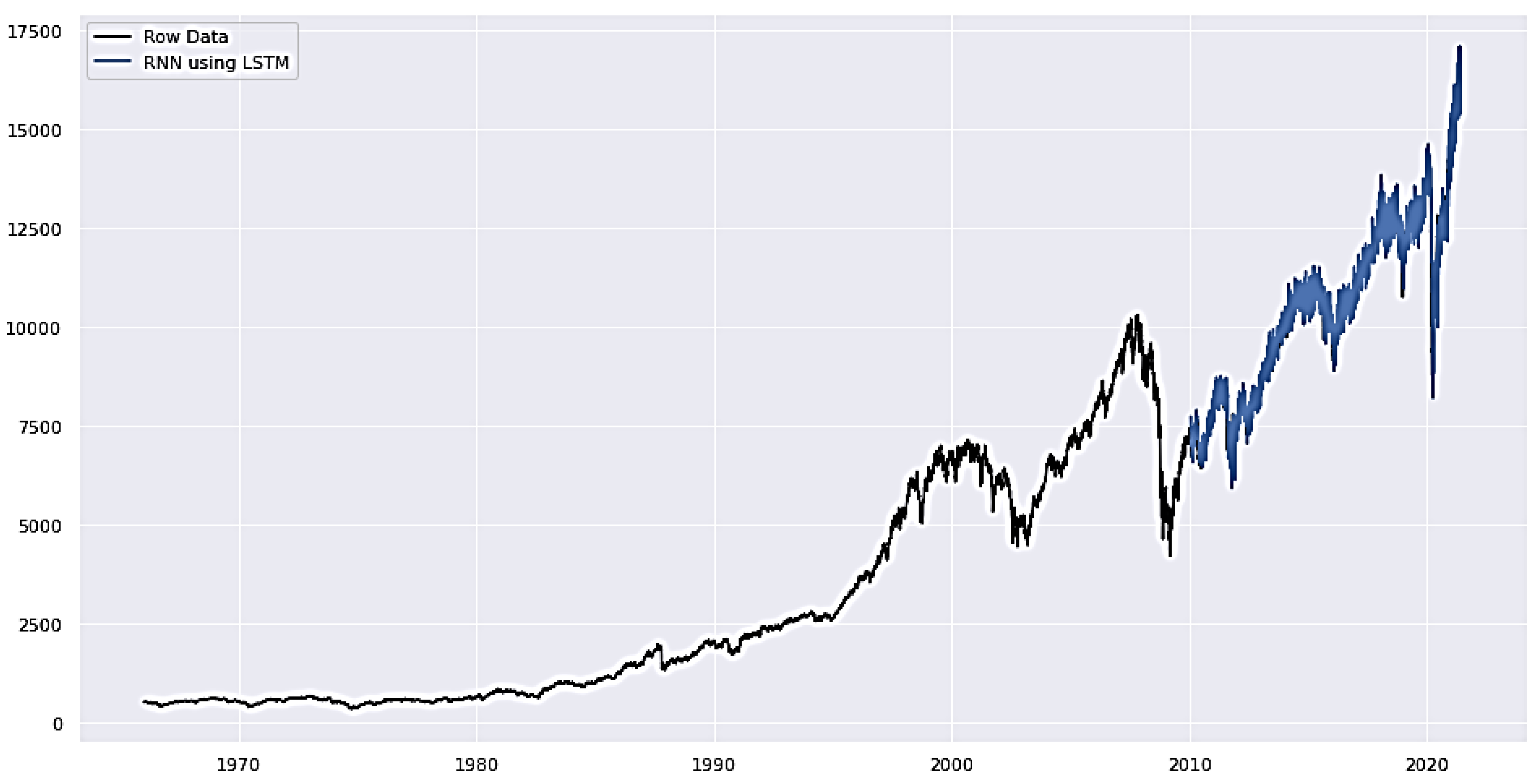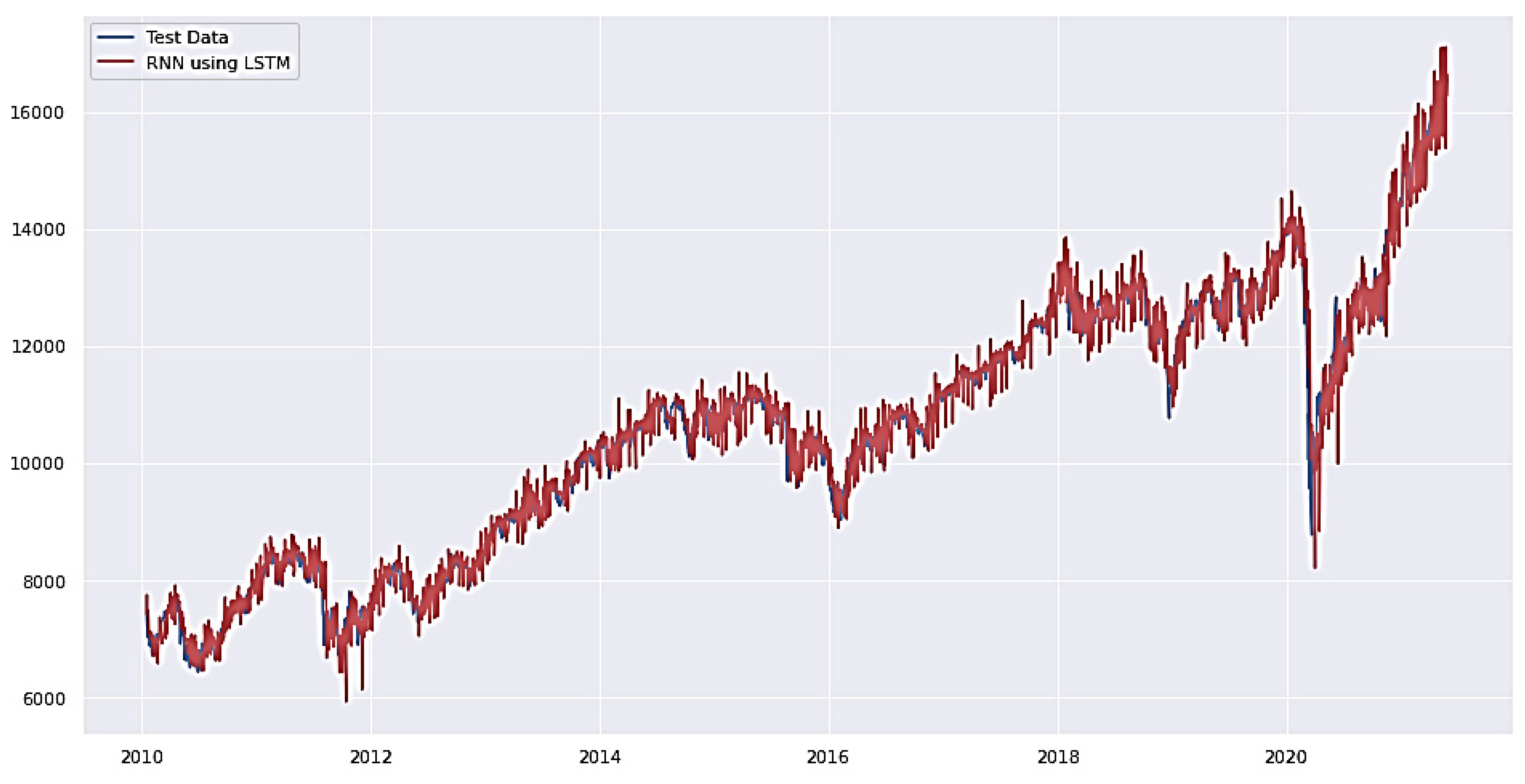1. Introduction
Cloud computing resources are commercially available as cloud services, with the paradigm being one in which producers sell to consumers. From an economic perspective, services are valued economic products that suppliers create and lease to customers [
1,
2]. In a specific payment mechanism, cloud customers can purchase items from suppliers based on their demands. It is commonly understood that the rent-borrow theory, random value programming’s optimal resource strategy, and economic resource strategy are good starting points for designing cloud computing resource allocation approaches [
3,
4]. In modern capitalist economies, financial markets play a crucial role in distributing resources and providing liquidity for entrepreneurs and firms. These markets allow for the easy buying and selling of financial assets; they create securities that provide returns for investors and enable individuals with excess capital to lend it to those in need. This analysis focused on financial markets such as the stock market and employed a game theoretic model to make predictions about stock prices [
5,
6].
There are several economic factors to consider in regards to cloud computing, including computing resource markets, the extent of cloud market economies, and the paid features of resources provided by cloud computing service providers [
7]. The market mechanism, which has the benefit of applying economic principles to cloud resource distribution, is known for reflecting changes in resource load, congestion, or supply and demand in commodity prices that fluctuate. Using equilibrium theory, it is possible to achieve optimal resource allocation. This dynamic coordination of resource allocation gives the cloud computing environment a mechanism that can be dynamic. Each market participant has the goal of maximizing their own interests [
8], leading to an overall improvement in resource allocation towards its ideal state. While the market mechanism is a classic technique for resource distribution, it can be challenging to implement [
9,
10].
Game theory and the market economic model are the foundations for studying strategies for providing cloud computing resources. The game theory model begins by solving equilibrium, with the goal of the algorithm being to create a suitable resource strategy by maximizing the utility of each utility function [
11]. This approach takes into account efficiency and fairness constraints in non-cooperative games to further increase overall profit. It has the potential to provide dynamic techniques for allocating resources based on the relative costs of different phases of development, but it is necessary to improve the accuracy of uncertain resource prediction. As a result, the cloud resource management paradigm (Service Layer Agreement) still has missing aspects, such as resources or price dynamics, despite considering the economic perspective.
Literature has investigated a QoS-based system for managing resource allocation, with several authors presenting various resource management approaches with different policies and concepts in recent years [
12,
13]. However, much of the material reviewed focuses on large-scale cloud-based systems with multiple subtasks, so cross-task collaboration should be explored. Existing algorithms, on the other hand, were too conservative as they did not take into account communication across tasks. The dependent task scheduling problem does not have an easy solution, as previously mentioned. Heuristic methods have been developed for near-optimal solutions.
This article divides the topic into five different parts. The introduction is presented in
Section 1 and the studies that are relevant to this investigation are discussed in
Section 2. The research procedures are discussed in
Section 3. The study’s findings and interpretation are presented and discussed in
Section 4 and its conclusion is highlighted in
Section 5.
2. Related Studies
There have been numerous approaches to solving the optimization issue using game theory. Within the field of game theory, there are both non-cooperative and cooperative game theories [
14]. The Nash equilibrium is a common solution in non-cooperative games. Many ideas have been developed using the Nash equilibrium as a foundation. For example, a level game model was presented that looked at how user task execution influenced resource selfishness in multiple administrative domains, but it ignored the connection between resource suppliers. The literature has also proposed a distributed actively non-cooperative abandon model [
15], which was able to reduce task execution time due to priority resource allocation. However, it is not clear if the Nash equilibrium solution is the only possible option in a pricing approach based on game theory that aims to solve the Nash bargaining dilemma. Current works often investigate the interaction between users and resource providers but ignore the link between cooperation and competition on the final resource outcome and treat resource providers as rational entities. Researchers have suggested market-based resource management as resource suppliers do not have the constraints of efficiency and fairness [
15].
While resource allocation methods have been studied in the past, to the best of our knowledge there has been less focus on developing an allocation strategy that aims to achieve the optimal distribution of resources. Such a strategy would adapt to dynamic changes in supply-demand, resource load, and congestion by pricing floating reflections and also aim to provide optimal resource allocation through equilibrium theory [
16]. In this study, we propose a supply strategy and two resource allocation algorithms based on the market economics model to improve efficiency while also being fair in the allocation of cloud computing resources. According to our experimental findings, the algorithms we presented perform better in allocating resources. Non-cooperative theory-solved resource allocation issues may lead to a Nash equilibrium according to the results of our experiments [
17]. In order to achieve efficiency and fairness, non-cooperative game analysis with Pareto improvements was used during negotiations.
Recent studies have focused on the economics of cloud computing, using various economic techniques for cloud resource pricing. This approach was tested on Amazon EC2 and private infrastructure, and the findings showed that Amazon’s pricing practices are unfair to its customers. Researchers have developed a method for calculating net profit based on cloud storage capacity [
18]; this method helps individuals choose a reputable service provider by identifying their needs and introducing a cloud resource allocation architecture based on a commodity price technique. They have also proposed a bidding exchange-based market for resource allocation and pricing, where users and service providers make requests and offers, and if a good match is found, resources are distributed [
19]. This platform utilizes Altman’s model. However, it is difficult to implement due to the current cloud infrastructure and communication exchanges, so most researchers choose to study markets with one vendor serving many customers. The capacity of economic approaches to provide optimal resource allocation and acceptable revenue for the provider when multiple resources and users are present has been demonstrated through the study of economic models and the analysis of statistical data. For example, Amazon’s EC2 service allows for the immediate sale of resources at significant cost savings, but the price technique used in on-demand situations is not publicly available due to business considerations. These researchers examined the impact of this new paradigm on both performance and cost [
20]. In an unrestricted computing environment, service providers may compromise their bid to perform work for users by setting up a dynamic auction and making various modifications to it, ultimately selecting the lowest-priced option for their new client based on available resource capacity [
21].
Economists have also attempted to address other problems through economic models. They determined whether computing resources could be made available on demand and proposed a workload prediction model based on long-term estimates [
22] for supplying VMs based on workload prediction factors that were non-centric and delivered in real-time. They examined the allocation of VMs from a real machine sample for automated resource management, showing that their methodology ensured both service level agreements and resource usage at the same time. The researchers also developed a system for allocating cloud resources based on when scientific workflows need to be completed [
23]. Using energy measurement techniques developed for physical computing resources, they advanced the ability to track the usage of each individual VM in an effort to forecast and minimize the cost of central electricity supply. They developed a method for identifying patterns in server workloads to combine and merge VMs [
24], packing several VMs into a limited number of resources to maintain high service quality while incorporating criteria for optimizing resource use and reducing expenses to reduce the cloud provider’s costs and increase profits. The approach aimed to control both performance and costs by optimizing computing resources based on utilization and reallocating VMs as they run. Most customer requests exceed the available computer resources, so corporations can increase revenue by eliminating unnecessary ones [
25]. In their view, the winning bidder is the one who offers the highest price and is therefore required to fulfill their promise to pay the bid amount. Another study found significant differences between three different types of bid-winner auctions in terms of execution time or consumptive energy. When it comes to grid and cloud resource allocation, several commercial and scientific platforms utilize economic methodologies [
26].
3. Materials and Methods
Economic cloud computing solutions are constructed using an infrastructure interface and middleware. The problem of resource allocation in cloud and grid systems is solved using final equilibrium theory and optimization from the perspective of the user. To maximize the utilization of available resources, computing economy cooperation is limited to achieving equilibrium between cloud service users and providers, thus avoiding competition between different categories of users. Non-centric models view the environment as perfect and non-competitive, which is a common issue. Mobile agents in these models have complete knowledge of their rival’s information, which is highly unlikely in the real world. Hierarchical game theory models (greedily) have been used as pioneers in grid computing systems. Both the equilibrium point approach and issue optimization strategy have been applied to utility-based public modes [
27].
In an alternative study, a strategy for allocating resources to multi-agent systems was shown to be effective. This approach relied on the existence of a Nash equilibrium point. Commercial agents were able to improve allocation outcomes by introducing new bids and altering their beliefs about the environment. An evaluation of research movement processes and decision-making variables in the cloud suggested that economic scheduling methods may be a viable option for further research in this area. This study focused on predicting stock values using game theory in the context of cloud computing. It compared the performance of different models such as regression, random forest, decision trees, and raw data [
28,
29].
Game theory was originally a subfield of microeconomics, which is the study of how people make strategic decisions. Over the past decade or two, it has expanded to a wide range of disciplines, including sociology, psychology, and evolutionary biology. It can be used to explore various strategic decision-making scenarios, such as the creation and maintenance of cooperation in communities and organizations, the simulation of immoral or illegal behavior, or the decision-making process of epidemic vaccination. The widespread application of game theory is due to the fact that strategic decision-making scenarios are common in many fields [
30]. Game theory typically involves two or more participants in a game, each of whom has a variety of tactics and pay-off values (also known as utility values) to choose from, often represented in a pay-off matrix for two-player games. Game theory is divided into two main categories: cooperative and non-cooperative [
31].
4. Proposed System
The advent of cloud computing has provided numerous options and economic benefits, marketing strategies, and access to significant computing resources. One of the main advantages of using the principle of economic cloud computing is addressing the significant resource challenges faced in the market cap. Marketing strategies in this context may include billing methods, congestion techniques, and dynamic demand management. Cloud computing also allows a diverse set of users to access resources simultaneously, as depicted in
Figure 1. Economic computing can be divided into several categories such as users, resource consumers, market analysis, and resource management. Users refer to cloud computing users who are ready to deploy their ideas in the cloud, including Quality of Service. This process involves users submitting their CPU type, storage system, and the current version they possess. All risks are analyzed in the resource market, which may involve up to six different mechanisms to address these risks.
Cryptographic techniques and usage policies must be taken into consideration when accessing data. The system should check its policy rules and only reveal the data if the policies are satisfied. While traditional cryptographic techniques can be used for data security, privacy protection and outsourced computation require more attention, as they are relatively new research areas. Data provenance, or the history of data, is also beginning to be addressed in the literature. In some cases, information about a specific hardware component (such as storage, processing, or communication) must be linked to a piece of data [
32,
33].
To optimize resource utilization, cloud service providers often use virtualization technologies that separate application services from infrastructure. Cloud service providers and integrators must collaborate to provide newly composed services to customers, requiring automatic service provisioning and composition frameworks that allow them to describe services using unified standards, discover interoperable services, and securely integrate them to provide services. These frameworks must include a declarative language to describe services, features, and mechanisms for provisioning and composing appropriate services.
The task was parameterized using the Poisson flow with the exponential distribution method, creating a list of queue models. The exponential distribution was represented by (μ). Virtual Machines were responsible for monitoring and accepting service requests. According to
Figure 1, users are considered the first group of developers and are directed to resource consumers and market analysis, which includes Virtual Machine (VM) monitoring, scheduling, and service monitoring. In the market, users compete using a non-cooperative game model. The main focus of NCGRAA is stakeholder analysis and effective resource management.
When negotiating global digital commerce regulations, game and collaboration coexist, and all parties actively pursue cooperative relationships while negotiating the game. Against this backdrop, this article presents a complete summary of the global digital trading rules negotiation process and analyzes the fundamental concerns of the discussions and their implicit political game. This article analyzes the key concerns of global digital trade rules that talk at the multilateral and regional levels. A dynamic conceptual Static Negotiation Analysis Method with Bargaining Process (SNAM-BP) statistically depicts the weighing connection between main concerns and keywords. To assess each country’s prospective alliance, we used the following Equation (1).
G is an imagined game in which each player can gain their utility for many modes of strategy . If no change in a Casino Game player’s strategy leads to large, low, etc. increases in other players and the amount of execution, the profile of strategy is a Nash equilibrium point. Based on time steps, Equation T_ illustrates the prediction of each job on each resource .
Assume that
seems to be the
sum of the task by the following Equation (2)
bids for such resource, so that’s
the price of one resource at that time.
The
time spent doing the job
on resource
is defined as follows in Equation (3).
The
the resource
ultimate execution cost is defined as follows in Equation (4).
If
is believed to represent the payout, all players will have the fastest task execution speed; hence, the best decision will have the lowest payment to represent Equation (5). When the price is seen as a payout
, on the other hand, the most expensive strategy consistently outperforms alternative methods.
If
the goal among all players is
to save time and money, the
best objective function the following Equation (6) for a player
is
.
To
get the Raw Data
for Yearly Stock Prediction Equation (7), first get the raw data.
Against this backdrop, this
presents a complete summary of the
global digital trading rules negotiation process the Equation (8).
It analyzes the fundamental concerns of the discussions and their implicit political game by the following Equation (9).
It arrives at the following result by Equation (10), which simplifies the preceding equation and uses derivation.
Based on the partial derivative (price parameter) the following Equation (11) is obtained.
Equation (12) analyses the key concerns of global digital trade rules talks at the multilateral and regional levels.
Based on the values of
t, the partial derivative
(time parameter) is represented in Equation (13).
A dynamic conceptual Static Negotiation Analysis Method with Bargaining Process specified in Equation (14) statistically depicts the weighing connection between main concerns and keywords. This equation is used to assess each country’s prospective alliance.
5. Results and Discussion
Table 1 shows a sample data visualization based on index data. Various attributes like daily opening value, closing value, and high and low values are presented.
To aid comprehension, raw data is again extracted from the dataset and presented on a graph. The data is drawn from of the dataset presented in
Figure 2, which spans the years 1970 to 2020.
A conceptual static negotiation analysis method with bargaining process model aids in the yearly stock prediction using raw data with a group formation for global digital trading rules negotiations from the standpoint of a political game. The empirical testing used data from 62 critical digital trading nations. Compared to traditional trade deals, the number of digital trade limitations and political distance significantly affected the level of consensus established in digital trade discussions (
Figure 2).
Following the implementation and execution of the suggested static negotiation analysis method with bargaining process model, the stock value was forecasted using the raw data provided in the dataset. The forecast was compared to other static negotiation analysis methods with bargaining process models described in the literature study. The prediction was performed in two stages: first with raw data and then again after data cleaning.
Figure 3 depicts a forecast based on raw data for the stock market, whereas
Figure 4 depicts a prediction based on actual data for game theory.
In comparison of predictions (exact value) terms of digital commerce, a country prefers to partner with countries with similar degrees of digital trade prohibitions. As partners, they have a high level of political similarity. The most importantly digital commerce constraint is financial and trade barriers. The nations consider while negotiating, and stability seems to be the essential political issue that countries consider. During bargaining, pay attention. In comparison to industrialized countries, emerging countries place a greater emphasis on market size. Take into account cultural and technological disparities during negotiations. The evolution of standards for international online trade can take several shapes.
Figure 4 depicts the path of rebuilding from bilateral to local to multilateral, promoting regional digital rule frameworks at this level and gradually widening the scope of conversations to cover worldwide problems.
For the game theory applications in the context of cloud computing, the suggested prediction model was assessed by comparing the predicted data with the training value (see
Figure 5). It demonstrated that the predicted value outperformed the learned values. The prediction static negotiation analysis method with bargaining process model discarded the very low and high values that occurred only a few times. To improve prediction accuracy, the proposed model employed LSTM after RNN.
Prediction was also performed on the data after it has been pre-processed and clustered. The projected stock value was compared to the actual value throughout the training process, and the result is shown in
Figure 6. In addition, throughout the testing procedure, the predicted value was compared to the actual values, as shown in
Figure 7.
The total results obtained with the suggested prediction model show that prediction accuracy is much like the actual value and that it is superior.
The training phase of the random utility estimation pipeline presents a significant challenge due to the heavily imbalanced data of resources, which had a disproportionate number of “off” samples compared to “on” samples. This imbalance can lead to potentially poorly trained models and is a result of the typical patterns of resource usage in buildings. To address this issue, mechanisms were implemented to reduce the complexity burden on the auto-encoder. Using a recurrent-based variational auto-encoder allowed for the generation of new data with significant similarity to the training data and greater flexibility in the application of the data in real-world scenarios such as demand response. These models were tested on multiple sets of data from individual occupants and demonstrated their ability to handle larger, more complex distributions like those found in social game time series data.
To evaluate the results, hypothesis testing (A/B testing) was conducted using data on dorm occupants’ usage before and after the start of the experiment. The hypothesis testing values for the different devices in both the Fall and Spring iterations of the experiment are shown. The data points, which represent the average usage of all occupants and are grouped into weekday and weekend data, were measured in minutes per day. For all devices, there was a significant decrease in usage between the two periods. The ∆% column shows the reduction in the average usage of all participating occupants. The p-values from the 2-sample t-tests demonstrate that the changes in usage patterns are significant. In addition, there is a much larger drop in usage over the weekends. These results are important because they show the ability of our methods to effectively incentivize occupants in residential buildings to make their energy usage more efficient.
